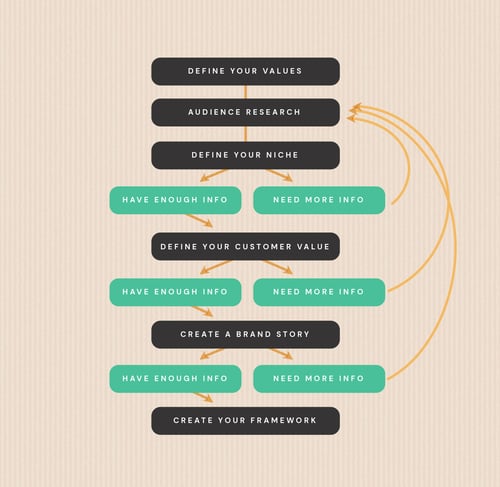BLOG Building a Brand Messaging Strategy
Building a Brand Messaging Strategy
POSTED BY Danielle Holmes | Jun 27, 2022

We did some very informal research and asked on social media what people thought brand messaging was. We posted on IG accounts, we asked our friends and family. And the answers made a lot of sense.
Because when we don’t have formal training or first-hand experience, we often take our understanding of topics from popular media, easy-to-read articles, and social media. And half of the marketing articles you read online are written for SEO, to play the Google algorithm, and sound smart. And as someone who works in marketing and ran a business, I’m not sure many of the top articles for this topic on Google were actually helpful. Go ahead, look them up!
Branding and building a brand message is more than “6 Simple Steps to Branding.” Building a brand message is based on truly, deeply knowing your values. And on truly, deeply knowing your audience. There’s no flow chart for that.
How-To Flow Charts Are Flawed
Most articles about brand messaging are going to give you a numbered list, with descriptions, and a flow chart or visual of what the process should look like. A flow chart is problematic because many of the steps that go into building a brand message may require jumping around, doing additional research, or returning a previous step. Basically, the flow chart is easy. The process itself doesn’t have shortcuts.

Define Your Values → Define Your Niche → ID & Research Your Target Audience → Define Your Value to Your Customer → Create a Brand Story → Create Your Framework
It feels easy, right? Download our flow chart and fill it in. Except, that’s not enough.
Brand Messaging is Rooted in Values
Brand messaging strategies are a study in values, translated into a story, that make your ideal client the hero.
And that takes work, research, and time.
Define Your Values
Here’s your first exercise. List your brand or company’s top 3 values.
If you listed anything like dependable, authentic, or integrity you actually have a list of social idealisms—not values.
Social idealisms “reflect ideas of how you should, ought to, or have to behave—not what you value most.” (Demartini 2013, 11) Values are specific to you, your brand, and season you’re in.
Dr. John Demartini describes values as, “specific to you as your fingerprint, your retinal pattern, or your voice print….they are the very essence of you: what you’re drawn to, what you inevitably seek out, what you live for.” (Demartini 2013, 12)
This personal approach to values also applies to your brand. Your brand’s values are unique. So, before you go any further, we recommend deep diving your brand’s values. A few of our favorite value resources are:
- The Values Factor by Dr. John Demartini
- Building a Storybrand by Donald Miller
After you deep dive your specific, descriptive brand values, it’s time to think about your brand’s niche.
Define Your Niche
This is more than a list of your services and products (you’ll need those too!). This is where you define what sets you apart from your competitors.
Say you’re a freelance copywriter. Your service offerings include:
- Wordsmithing (light editing of existing content)
- Copywriting (full rewrites or content creation)
- Messaging strategy
And you do this for three categories: web, blogs, and social media. These service offerings do not define your niche. These offerings are common for professional copywriters.
Your niche looks at who you serve and how you serve them.
For a professional copywriter, that might look like:
I provide transformative copywriting services for brands and solopreneurs who prioritize their why and see their brand as part of a story. And this often happens to be for woman-owned businesses.
Your niche is woman-owned businesses that see their brand as part of a story.
Exercise: Stop what you’re doing and think through your offerings, who you serve, and what you serve. Then turn that information into your niche.
But before you move on, run this description of your niche through your values. Ask yourself, do they align?
Identify and Research Your Audience
Here’s the kicker. If you don’t know your audience, you won’t have the information to describe your niche. So, if you are having trouble identifying your niche, consider doing audience research first.
We’re not going to get into how to do audience research here. That’s its own topic. If you haven’t done audience research before, I highly recommend this article. You might look at your current clients or buyers, the demographics of people visiting your website or marketing platforms, or industry information. Or you might pivot and decide who you want your audience to be.
Once you’ve identified your audience, find out everything about them. Likes, dislikes, hobbies, education, income, marital status—the options are endless. For a full list, check out this article.
Define Your Value to the Customer
Alexander Chernev says functional value can be divided into three categories. How these categories apply depends on how you relate to the product. If you really want to get into this, his book, Strategic Marketing Management applies almost an entire chapter to this topic.
|
Functional Value - this describes how the service or product physically impacts the client. If you were selling laundry detergent, it’s functional value would be getting stains and smell out of clothes. |
Psychological Value - this describes a client’s emotional response to the product, how the offering allows the customer to express themselves, and how the customer perceives the brand’s positive impact on the world. |
Monetary Value - this describes the price, which may influence the buyer, and the financial benefits, of using the product. |
Exercise: Go through this matrix and define how your brand brings values to customers. Then, run those results back through your values. If you’re struggling with any of these categories, consider going back to audience research.
Build Your Brand Story
Now that you’ve gone through your values, niche, audience, and value to the customer, it’s time to get creative. Storytelling is a basic and primal communication method. Not only are stories easy to remember, the practice of storytelling is common to all cultures. Telling stories about ourselves, our lives, and the world around us is how we make sense of the world.
So, it’s time to make your brand memorable. Much like audience research, creating a brand is its own topic. So, I suggest this article on creating story brands and this article on using stories for websites. The biggest thing we see as professional marketers is that your client or customer wants to be the hero of the story. If you’re looking for someone to walk you through this process, we actually include a brand story in your branding package. We’d love to help you!
Exercise: Use Donald Miller’s How to Build a Storybrand to create a brand story! Then, run it through your values.
Create Your Framework
Your framework is the written product you’ll use to inform all your marketing efforts. Your basic framework should have:
- Mission statement
- Tagline
- Value proposition
- Brand promises
A more complex framework includes:
- Mission statement
- Tagline
- Value proposition
- Brand promises
- Buyer personas
- Positioning statement
- Style guide or brand book
You’ll see many of these linked out to articles with definitions, examples, and guides.
SHARE THIS POST:

About the writer, Danielle Holmes
Danielle has been telling stories her whole life. And for the last five years she’s been telling the stories of entrepreneurs, small businesses, and companies bringing quality products and services to customers. Danielle got her start in academia. With degrees in English and anthropology, she spent more than half a decade learning how to ask questions, tell stories, and do thorough research. Her approach uses ethnographic interview and coding techniques to better understand brands and clients. She listens for key words, recurring topics, and core ideas to know the client and their ideal audience. She uses that data and understanding to tell stories—true to brands—that create loyal customers.
